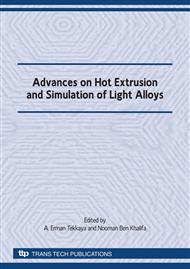p.121
p.129
p.137
p.145
p.153
p.161
p.167
p.173
p.181
Friction in Double Action Extrusion
Abstract:
A novel extrusion testing method, double action extrusion (DAE), to highlight the effect of friction at the die bearing in aluminum extrusion was developed. It was found that the lengths of the extrudates and extrusion force were indeed sensitive to the die bearing length and thus to the friction. FEM simulations of DAE were carried out to evaluate the shear and Coulomb friction models over a wide range of friction factors/coefficients from 0.2 to 1. The full sticking friction appeared to represent the interfacial contact between hot aluminum and die the best. The friction factor values in the shear friction model over a range of 0.3 to 0.6 commonly used to describe the contact at the billet-die interface in FEM simulation appeared to be too low. The comparison between the experimental and simulation results indicated that the shear friction model at m = 1 predicted the extrusion force the best, while the Coulomb friction model at µ = 1 predicted the extrudate lengths the best. Of the existing friction models and friction factors/coefficients, it is recommended to use the shear friction model at m = 1 to describe the friction at the billet-die interface in FEM simulation.
Info:
Periodical:
Pages:
153-160
Citation:
Online since:
December 2009
Authors:
Keywords:
Price:
Сopyright:
© 2010 Trans Tech Publications Ltd. All Rights Reserved
Share:
Citation:


